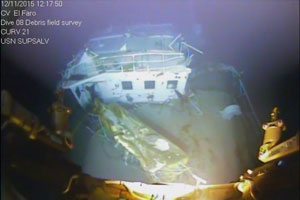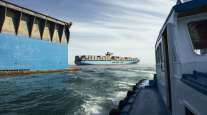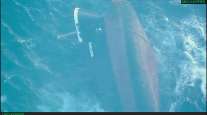NTSB Releases Haunting Video of El Faro Wreckage on Ocean Floor

The underwater images are haunting, a reminder of the storm's savagery and the remote location of the 33-member crew's final resting place — about 3 miles below the ocean's surface.
Among the photos were ghostly images of twisted beams and metal, a microwave oven, a printer and a vehicle with a sunroof.
The NTSB released the images in conjunction with a report about the El Faro on "60 Minutes," the CBS News program. The program was titled, "Lost in the Bermuda Triangle." The El Faro left Jacksonville, Florida, on Sept. 29 bound for San Juan, Puerto Rico. The ship was carrying 391 containers topside and 294 trailers and vehicles below deck.
The NTSB, which has been investigating the cause of the sinking, also released the accident docket — documents containing nine photographs of the wreckage.
NTSB spokesman Peter Knudson said in a news release that the agency also plans to provide more than 47 minutes of video — recorded by a cable-controlled underwater recovery vehicle — to the public at what he called a "nominal cost." In addition, NTSB released about two minutes of video footage that was uploaded to the agency's YouTube channel.
Although the Navy was able to locate the ship — the El Faro lies nearly 3 miles down in the Atlantic Ocean — the investigation has been stymied because the El Faro's voyage data recorder, or black box, has not been found.
"This is the most difficult and complex investigation I have ever worked on in my 17 years with the National Transportation Safety Board," Tom Roth-Roffy, NTSB's lead investigator, told CBS News correspondent Scott Pelley. "We've experienced this sort of challenge before on other investigations ,and we're hopeful that we will be able to determine the cause of the sinking."
Five Polish crewmen and 28 Americans were aboard the U.S.-flagged ship — including its captain, Michael Davidson, 53, of Windham; Michael Holland, 25, of Wilton; and Danielle Randolph, 34, and Dylan Meklin, 23, both of Rockland — when it sank.
All four were Maine Maritime Academy graduates, as was a fifth crewman, Mitchell Kuflik, 26, of Brooklyn, New York. Davidson, who graduated in 1988, was an experienced mariner.
After the ship sank, Holland's mother, Deb Roberts, created a Facebook page called "Making Waves for Mike — Bring the El Faro Crew Home Safely." The page has more than 4,100 followers and Roberts regularly posts messages.
On Jan. 3, she wrote, "To all crew family members out there, please know you are in my thoughts always but especially tonight as the images of our loved ones' final resting place will be shown to the rest of the world."
Roberts was among five family members interviewed by Pelley for the "60 Minutes" segment. When asked whom she holds responsible, Roberts replied: "I'm not a professional. I'm not an engineer, I'm a business manager. I think it was a series of unfortunate events and, without any other information, I truly blame it on Hurricane Joaquin."
Not everyone was as kind as Roberts. Glen Jackson, whose hometown was not identified on the program, lost his brother, who was a crewman on the El Faro and was not from Maine. Jackson blames the ship's owner — Tote Maritime — for sending the crew into the storm.
"And you got to understand commercial shipping. They got to keep that ship moving to make money. And it — that's the whole horror of this tragedy — is that 33 people died so that frozen chickens could be delivered on time in Puerto Rico."
The 790-foot El Faro was lost Oct. 1 during Hurricane Joaquin. It is being called the worst U.S. maritime disaster in 35 years. The 40-year-old ship was owned by Tote Maritime, which declined to be interviewed by Pelley.
Pelley was allowed to accompany the crew of the Apache, a Navy salvage and diving vessel that used cameras attached to an underwater, remotely operated robot called a CURV-21 to film the wreckage.
The ship's voyage data recorder would have given investigators access to the conversations that occurred on El Faro's bridge and clues to why the ship sank. But the device was lost when the vessel's top two decks, including the bridge, were shorn off. The bridge eventually was found, but the mast and the base of the mast to which the voyage data recorder was attached have vanished.
"We were looking, of course, for the bridge and the voyage data recorder," Roth-Roffy told "60 Minutes." "We got up to that level [of the ship] and to see just openness, is extremely moving and difficult. ... It was a very big surprise."
Roth-Roffy said the image made him realize that some of the crew may have been swept away with the two decks.
When Pelley pressed him to say why he found it moving, Roth-Roffy hesitated, and became emotional. He told Pelley he was struck by the violence of the sea and winds that were churned up by the storm and which had the power to cause such destruction.
At the time of the El Faro's departure, Joaquin was classified as a tropical storm. The National Weather Service issued an advisory upgrading Joaquin to hurricane status while the ship was several hundred miles into its voyage.
According to CBS News, Davidson was planning to steer 65 miles south of the hurricane's path.
On Oct. 1, the El Faro lost propulsion and was unable to evade Joaquin, which grew to a Category 4 hurricane with winds that topped 130 mph, leaving the ship helpless to avoid the storm.
NTSB Chairman Christopher Hart told "60 Minutes" that it could take as long as a year before more details about the sinking are uncovered by the investigation. Hart did not rule out the possibility that the voyage data recorder could be recovered. He did not elaborate.
The El Faro sank to a depth of about 15,000 feet into what Pelley described as an abyss of "impenetrable darkness."




